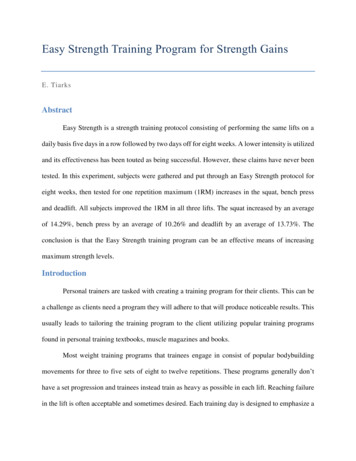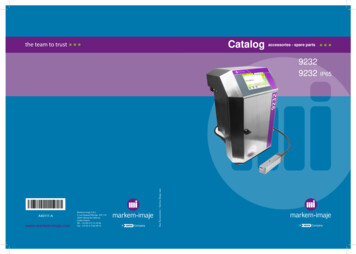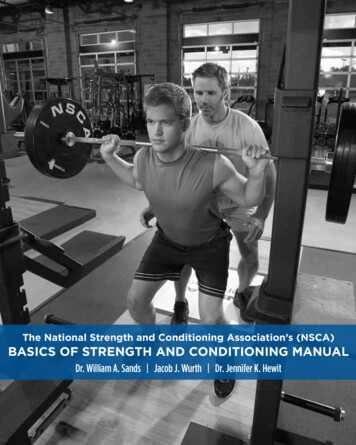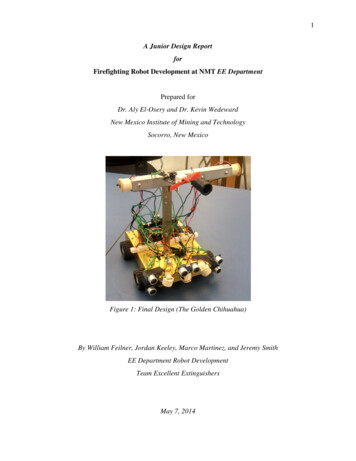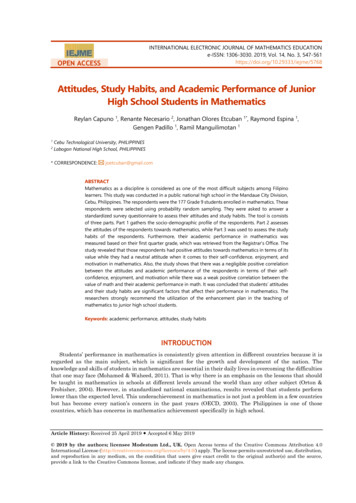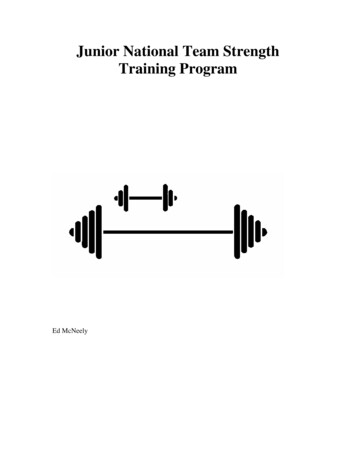
Transcription
Junior National Team StrengthTraining ProgramEd McNeely
The majority of rowers use some form of resistance training in their preparation for therowing season. While strength is obviously very important for a competitive rower howstrong does a rower have to be? Does is really make any difference in rowingperformance if you increase the weight you can squat from 500 lbs. to 550 lbs.?Every sport requires a certain level of strength to achieve optimal performance.Increasing strength beyond these levels does not necessarily improve performance and insome instances can be detrimental to performance. Once the ideal level of strength hasbeen achieved the time needed to increase beyond this point could be better spent trainingsomething else i.e. rowing technique, aerobic fitness, flexibility, or anaerobic fitness.How Much Strength do Rowers Need?There are several ways to determine the strength demands of a sport. A biomechanicalanalysis of the forces generated on the foot stretchers, oar lock, or at the blade canprovide good information on how much force is developed with each stroke. Elite rowersgenerate their highest forces on the first stroke of a race. These forces have been found toreach 1352 N, which is roughly equal to 135 kg, for men and 1019 N or 102 kg forwomen. Back in 1975, research on the East German National team indicated that theminimum level of rowing strength required for international competition was 133 kg.With the increases in boat speed and changes in oar technology this is undoubtedly highertoday.A second method for determining strength goals is to base them on the strength levels ofelite competitors. Presumably, if a competitor is medalling at the Olympics or WorldChampionships they are strong enough to be successful. This doesn't hold true all thetime because of differences in technical efficiency and aerobic fitness but it is a goodstarting point. In order to study maximal force generation at the catch Secher developedan isometric apparatus that was adjustable so as to suit individual rowing positions. UsingDutch Olympic, national, and club level rowers it was found that international rowers onaverage generated 204 kg of force. National level rowers generated 183 kg of force andclub rowers generated 162 kg of force. Using other non-specific rowing tests – isometricarm pull, back extension, trunk flexion and leg extension – on the same groups ofathletes, it was found that the higher the competition level of the rower the greater thestrength in all tests.The use of non rowing tests of strength has it's pros and cons. Force application in a boatis technically different than it is in a leg press or squat. While these tests are very goodfor determining if the muscles are strong enough to do the job they don't necessarilyreflect someone's boat moving ability. Weight lifting tests do have the advantage of beinglow tech, they don't require computer links to strain gauges or force plates, and easy toadminister. Concept II has developed a machine called the Dyno which works on thesame air resistance principals as the erg but can be used for strength training and testing.This is a very well made machine and in time will probably become a standard tool forstrength testing for rowers. Unfortunately, because it has only been on the market for acouple of years I can't provide any strength norms for it yet.
Strength and Body weightStrength can be classified as either absolute or relative. Absolute strength represents themaximum amount of weight that can be lifted one time. Larger people tend to havehigher absolute strength than smaller people because they carry more muscle mass.Relative strength is the maximum amount of weight that can be lifted one time in relationto bodyweight. Relative strength is of more importance to a rower than absolute strength.The amount of weight in a boat affects the drag through the water. Increasing absolutestrength is of no benefit if the weight gain offsets the strength gain by increase resistancethrough the water. Increasing relative strength makes it easier to accelerate the boat witheach stroke because strength has increased without increasing the drag. It is because ofthe importance of relative strength that the strength goals presented here are expressed aspercentages of bodyweight.Strength GoalsThe table of goals below have been developed from the data I have collected during myconsultation with rowers from novice high school rowers to Olympic Champions as wellas from an examination of the force and strength research that has been done. Because thegoals are expressed as multiples of body weight they are applicable to both heavyweightand lightweight rowers.Table 1. Strength to Weight Factors for MenSquatDeadliftBench PullHigh SchoolU .71.71.21.91.91.3Table 2. Strength to Weight Factors for WomenSquatDeadliftBench PullHigh SchoolU 51.41.41.11.61.61.2Using the TablesTo use the table take your body weight and multiply it by the appropriate factor. Forinstance if you were a 200 lb. Male club rower you should be able to bench pull 210 lbs.one time (200 lb. Bodyweight x 1.05 210). These tables are appropriate for rowers
aged 15-35. Strength normally decreases after age 35 and those under 15 should befocusing on technique and body stability instead of maximum strength. In a future articleI will provide tables for rowers over age 35.If you currently are able to meet these goals you can focus your training on other areas. Ifyou can't meet these goals strength may be one of the things holding back yourperformance. Here are some pointers to help you reach your goals:1. Take a Long Term Approach to Strength DevelopmentDon't try to achieve these goals overnight. It may take several years for you to reach thestrength goal at each competitive level. Notice how the strength level of Olympic rowersis twice that of the high school rower. The average age of Olympic rowers is 26-28 yearsold. This gives the high school rower about 10 years to double their strength. Rapidincreases in strength are possible but won't likely be maintained from year to year.2. Keep Everything in PerspectiveJust because you haven't achieved the strength goals that I have outlined there is noreason to panic and wildly change your program. Decreasing the amount of aerobictraining or technical training so that you can spend more time in the weight room mayhelp you reach your strength goal but it may not make you a better rower. Look at allaspects of your performance before changing your program. Aerobic and technicaltraining are far more important than strength is to your performance. If you feel that youare technically proficient and aerobically very fit then maybe you can decrease the timeyou spend on these things until your strength level improves. Otherwise work on theother things first.3. Don't Over Do itKeep strength training sessions short. Sessions that last longer than 45-60 minutes oftenlead to overtraining. Shorter more frequent training sessions cause greater strengthincreases than long infrequent sessions. Try to fit in 3-5, 45 minute sessions each week.4. Focus on Strength not Strength EnduranceUntil you have adequate strength, strength endurance training should be eliminated fromthe program. Strength increases do not occur with the high repetition, low resistancetraining common in strength endurance programs. Strength endurance training withoutadequate strength only means you are getting better at being weak.
A good warm up is essential for a good workout and must be done prior to each trainingsession. Warm up increases muscle temperature, flexibility, strength and endurance,making your workout more effective. There are two components to every warm up:General Warm UpFull body CalisthenicsA warm up starts with some full body calisthenics. Exercises like jumping jacks, ropejumping, push ups, sit ups, and lunges are full body exercises that will increase bodytemperature. These exercises should be done for a total of 2-3 minutes as the goal ofwarm up is to increase temperature not create fatigue.StretchingFollowing the calisthenics you should spend 3-5 minutes doing some dynamic stretches.Dynamic stretching is a more effective means of warm up stretching than staticstretching, meaning that rather than holding a stretch for a period of time you movethrough a full range of motion and then back to your starting position immediatelywithout holding the stretch. This is particularly true when you are doing power training.Several studies have shown that a static stretch immediately before power training cansignificantly decrease subsequent power development. In the warm up below each of thestretches is done 4-6 times in a dynamic fashion.General Warm Up10 Squat jumps - Quad stretch - 8 Walking LungesHamstring stretch- 8 Push Ups- Calf Stretch10 lateral hops- Arm SwingsSpecific Warm UpAfter you have completed the General Warm up you need to do a specific warm up forthe type of training that you will be doing. Keep in mind that warm up is just that warmup not training, fatigue should be kept to a minimum during warm up otherwise thetraining session will suffer.
Warming Up for Strength TrainingWhen weight training, do at least two sets, one at 50% and one at 75% of the workweight, before using the working weight. Very strong people need to do more sets. Manyelite powerlifters and weightlifters use six to eight warm up sets prior to opening attemptsin competition. Repetitions in warm up sets are low, 1-4, and done at a controlled speed.Warm up sets are done for every exercise in the program, not just the first exercise.Warming Up for Speed, Agility and Anaerobic TrainingAs in weight training a warm up for speed, agility and power events or training useswarm up sets. Prior to each drill start with a walk through set that allows you to rehearsethe drill in your mind and remind you of the movements and changes of direction thathave to be made. Following the walk through perform two progressively faster trials, oneat about half speed and one at three quarter speed. Be sure to focus on good techniqueduring each of the warm up sets, the way you perform in warm up will be the way youperform in the training session.Warming Up for Aerobic TrainingSince most of the aerobic training you will be doing is low intensity there isn’t a specificportion to the warm up. If you were to do higher intensity aerobic intervals you wouldstart with 10 –15 minutes of light aerobic work prior to starting the interval portion on thesession.Squat JumpsQuad StretchWalking LungesHamstring StretchPush UpsCalf StretchLateral HopsArm Swings
Strength training plays many roles in a training program, increasing strength, power andspeed, decreasing the chance of injury and improving technical performance. There areseveral general principals that need to be followed when performing your strengthprograms.SpeedThe speed of movement is noted using three numbers like 2-1-2 which coincide with thelifting part of the exercise, a pause at the top, and the lowering part of the movement. Inthe programs a speed of 2-1-2 means take two seconds to lift the weight, pause for onesecond at the top and then lower the weight for two seconds. It is very important tofollow the speeds listed, strength increases are specific to the speeds used so if you traintoo slow or too fast you won’t make gains at the speeds you need for hockey. For someexercises you will see explosive listed as part of the speed notation, this means move theweight as fast as possible for that part of the movement.Rest Between SetsRest refers to the time that is taken between each set of an exercise. The rest between setsallows your body the time to replenish the energy used during the set and plays a role indetermining the training effect. Rest periods for developing strength and maximalstrength are quite long, usually 3-5 minutes. Strength training with heavy weight and lowreps uses predominantly the anaerobic alactic energy system. The alactic energy systemrelies on the energy stored in the muscles. Energy is stored in the form of ATP and CP.These two compounds, known as the phosphagens, are available for immediate use. Thestored supply of these compounds is relatively small providing energy for about 10-15seconds of all out strength training effort. Once all the stored energy is used up the bodyrequires about 3 minutes to fully replace the phosphagens. If the next set is started beforethe phosphagens are fully restored the muscles will be forced to use the anaerobic lacticenergy system. This will result in a build up of lactic acid.Lactic acid is responsible for the burning sensation in the muscles. It also causes feelingsof heaviness and fatigue. A build up of lactic acid will inhibit the quantity and quality ofwork performed resulting in fewer strength gains. Unless specifically noted you shouldtake 3 minutes between sets.Selecting a Weight to UseWhile the rep range gives you a guideline for the amount of weight to use it is up to youto pick the appropriate resistance for your goal and fitness level. One of the most basicprincipals of training is the Overload Principal, which states that you need to continuallybe increasing the physical stress on your body in order for it to continue to adapt andbring you closer to your goals. Choose a weight that will allow you to just complete the
number of reps required for the low end of the rep range using good technique, use thisweight until you are able to perform two more reps than the required number using goodtechnique for all sets then increase the weight and start over again.
Junior Strength Training ProgramStrength 2Day 1Front SquatsCross over stepupsBench PullDB rowAlternate LegCurlSB Knee tucksSB Leg raises Day 2DB Split squatDeadliftDay 3SquatsLeg curlDay 4Overhead SquatRomanian DeadliftStep upsBench pressSB cable rotationsSB Pullo
Weight lifting tests do have the advantage of being low tech, they don't require computer links to strain gauges or force plates, and easy to administer. Concept II has developed a machine called the Dyno which works on the same air resistance principals as the erg but can be used for strength training and testing. This is a very well made machine and in time will probably become a standard .
